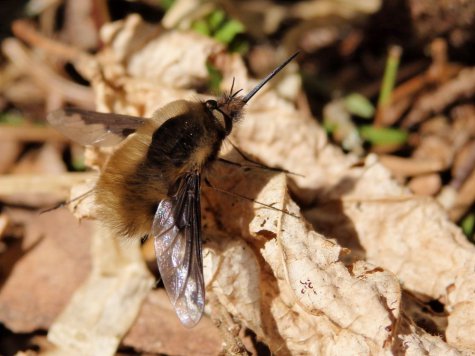Large bee-fly
Text and photo Ave Liivamägi
Translation Liis
Large bee-fly Mesilas-kägukärbes Bombylius major
.
From April to June a rather loveable fly can be seen in action. Its name in Estonian might be ”mesilas-kägukärbes”, bee cuckoo-fly. The name is not officially acknowledged yet. But because of its appearance the name would be quite justified. The furry and stout body makes one guess at a small bee or even bumblebee, but counting the number of wings makes it clear that a clever two-winged insect tries to confuse the observer for a moment.
This fly is peculiar also in that it has long, thin legs and a long proboscis, or sucking snout, that is visible on sucking nectar from flowers as well as at rest. In addition the large bee-fly is capable of hovering flight like the hoverflies (Syrphidae).
In terms of body measurements the bee-fly is quite small. The length of the brown fur-covered body is 10 - 12 mm, the proboscis adds another 6 mm. The span of the dark-edged forewings is 9 - 14 mm.
The larvae of the bee-fly live as parasites on the larvae of solitary bees and wasps. Hence the word ”cuckoo” in the proposed Estonian name is justified, alluding to its not very civilized lifestyle.
Large bee-flies are quite mobile. They quickly search for flowers to suck nectar from. On flying they generate a high-frequency sound that may be helpful in determining the location of the insect









